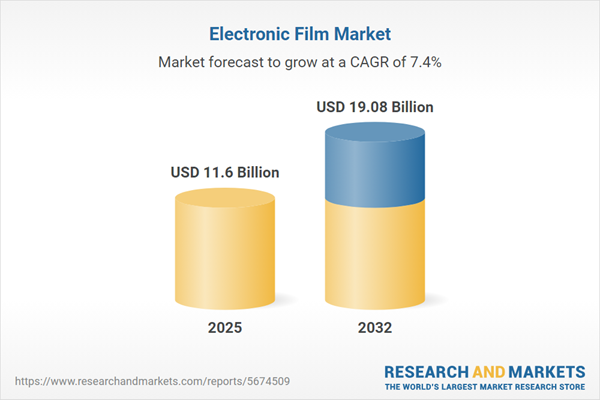Speak directly to the analyst to clarify any post sales queries you may have.
Electronic film technologies are revolutionizing the performance and design of next-generation electronic systems worldwide. As industry momentum accelerates, senior leaders are leveraging these innovations to unlock new functional and efficiency gains across diversified sectors.
Market Snapshot: Electronic Film Market Size and Growth Trajectory
The global Electronic Film Market grew from USD 10.78 billion in 2024 to USD 11.60 billion in 2025. This sector is projected to expand at a 7.39% CAGR, reaching USD 19.08 billion by 2032. Increasing demand for flexible, lightweight, and high-performance films in critical industries continues to shape the competitive landscape and drive long-term market evolution.
Scope & Segmentation of the Electronic Film Market
- Applications: Automotive (including head-up displays, infotainment, ambient lighting, and protective covers), consumer electronics (laptops, smartphones, tablets, wearables), healthcare (diagnostic displays, medical sensors, wearable monitors), and solar energy (concentrated solar power, photovoltaic modules, solar thermal collectors).
- Types: Amorphous silicon, monocrystalline silicon, polycrystalline silicon.
- End Users: Automobile OEMs, medical device manufacturers, mobile device manufacturers, solar panel manufacturers across all tiers.
- Functions: Anti-reflective, anti-scratch, decorative, and protective (dust resistance, UV protection, waterproofing).
- Thickness Tiers: Below fifty micrometers, fifty to one hundred micrometers, above one hundred micrometers (including sub-tiers above one hundred fifty and between one hundred one to one hundred fifty micrometers).
- Geographical Regions: Americas (North and Latin America), Europe, Middle East & Africa, and Asia-Pacific. Covered countries include United States, Canada, Mexico, Brazil, Germany, China, Japan, India, among others.
- Key Companies: 3M Company, DuPont de Nemours Inc., Eastman Chemical Company, Toray Industries Inc., FUJIFILM Holdings Corporation, SKC Co. Ltd., Sekisui Chemical Co. Ltd., Kolon Industries Inc., Jindal Poly Films Limited, Mitsubishi Chemical Corporation.
Key Takeaways for Decision-Makers
- Material innovations are enabling electronic films to deliver high performance across complex geometries, expanding their applicability in both established and emerging industries.
- Sustainable manufacturing and recycling protocols are increasingly central to maintaining regulatory compliance and customer trust, particularly in markets with strict environmental expectations.
- Flexible supply chain strategies, including regional manufacturing hubs, are proving vital for managing operational risk and ensuring reliable component sourcing.
- Partnerships between suppliers and OEMs are accelerating bespoke solutions, optimizing film properties for targeted application needs and market demands.
- Advancements in roll-to-roll processing and nano-coatings are streamlining high-volume production and supporting rapid innovation cycles for new products.
- Regional demand patterns underscore the necessity of tailoring both product offerings and distribution models to local regulations and end-user preferences.
Tariff Impact: Strategic Response to Regulatory Change
Proposed United States tariffs in 2025 are set to influence the electronic film supply chain, affecting raw material sourcing and finished product pricing. Senior leaders are proactively evaluating nearshoring, investing in alternative raw materials, and accelerating domestic manufacturing capabilities to enhance resilience and adapt to shifting cost structures. Stakeholders also view these regulatory changes as opportunities to strengthen collaborative research and drive strategic differentiation.
Methodology & Data Sources
This report utilizes a multi-tiered methodology, integrating secondary research from technical publications and regulatory documents with primary interviews from sector stakeholders. Quantitative trends are validated using proprietary supplier databases and global trade data. Analytical rigor and factual accuracy are further assured through expert peer reviews and advanced modeling techniques.
Electronic Film Market: Why This Report Matters
- Pinpoint actionable growth opportunities through rigorous segmentation by application, function, region, and end user in the electronic film industry.
- Access independent insights to inform capital allocation, mitigate regulatory risk, and guide strategic partnerships within your electronic manufacturing ecosystem.
- Leverage competitive benchmarking of major players and supply chain dynamics to strengthen positioning in evolving global and regional markets.
Conclusion
Senior decision-makers can use this research to navigate a dynamic electronic film market, anticipate future regulatory trends, and guide smarter investments. The detailed analysis empowers leaders to make informed decisions for sustained growth and competitive advantage.
Additional Product Information:
- Purchase of this report includes 1 year online access with quarterly updates.
- This report can be updated on request. Please contact our Customer Experience team using the Ask a Question widget on our website.
Table of Contents
3. Executive Summary
4. Market Overview
7. Cumulative Impact of Artificial Intelligence 2025
Companies Mentioned
The companies profiled in this Electronic Film market report include:- 3M Company
- DuPont de Nemours, Inc.
- Eastman Chemical Company
- Toray Industries, Inc.
- FUJIFILM Holdings Corporation
- SKC Co., Ltd.
- Sekisui Chemical Co., Ltd.
- Kolon Industries, Inc.
- Jindal Poly Films Limited
- Mitsubishi Chemical Corporation
Table Information
| Report Attribute | Details |
|---|---|
| No. of Pages | 197 |
| Published | November 2025 |
| Forecast Period | 2025 - 2032 |
| Estimated Market Value ( USD | $ 11.6 Billion |
| Forecasted Market Value ( USD | $ 19.08 Billion |
| Compound Annual Growth Rate | 7.3% |
| Regions Covered | Global |
| No. of Companies Mentioned | 11 |








